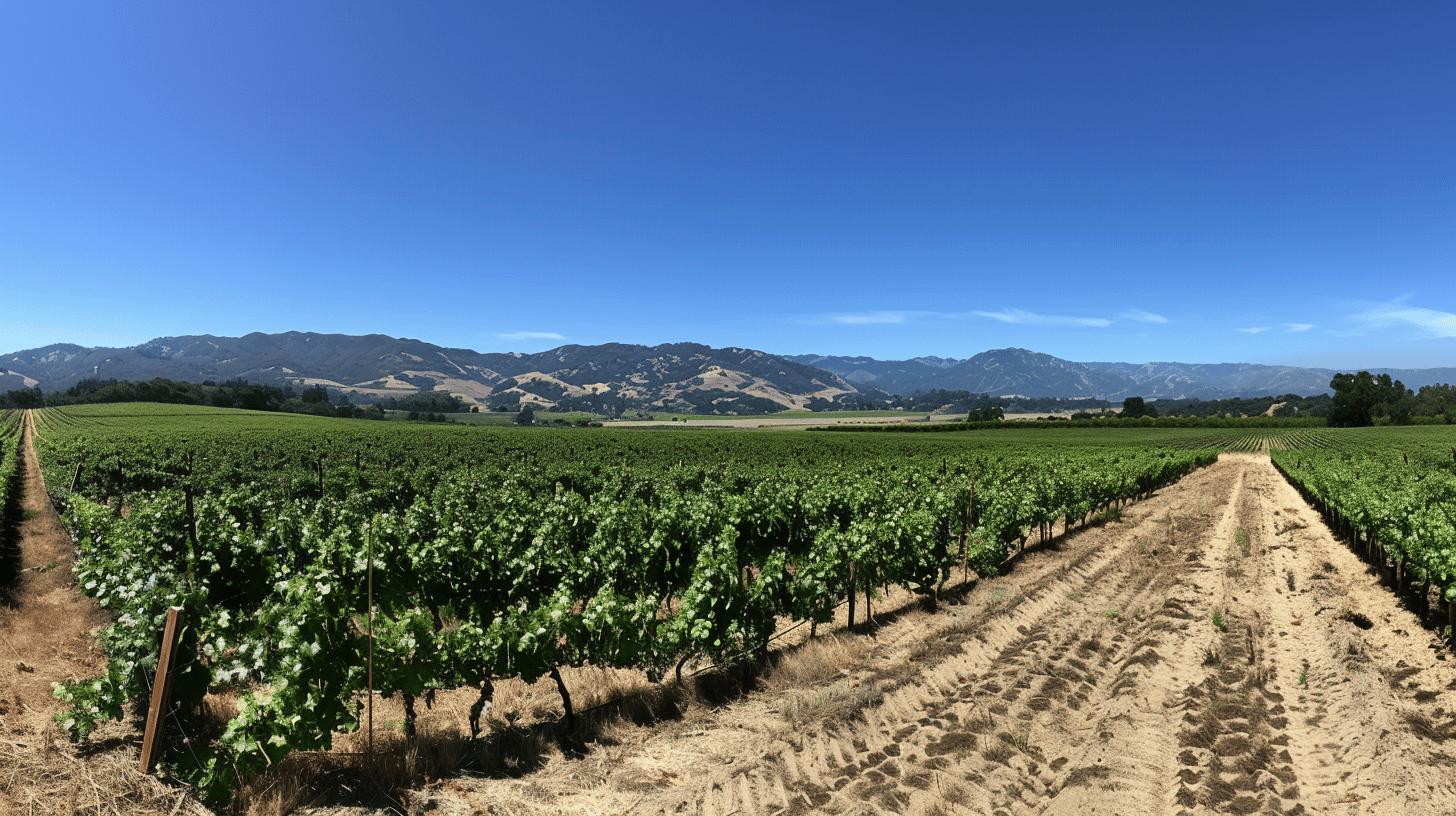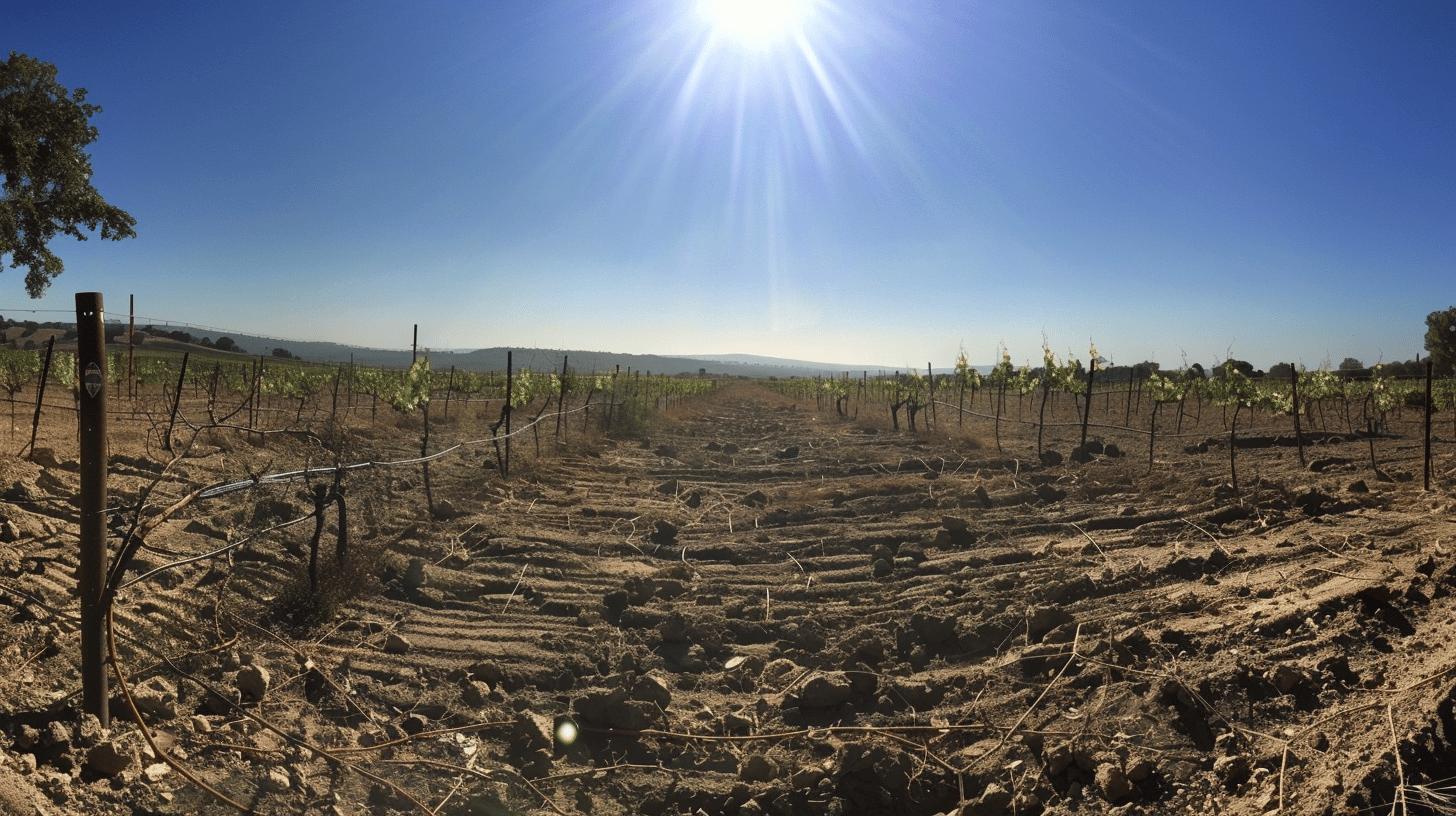Ever wondered why wines from Napa Valley taste so different from those of Bordeaux? The secret lies in the magic of climate and terroir. These factors are the unsung heroes shaping the distinct flavors and characteristics of New World wines.

From the sun-drenched vineyards of California to the windswept slopes of Mendoza, we’ll explore how climate and terroir team up to create spectacular wines with unique profiles. Ready to sip on some intriguing insights? Let’s uncork the mysteries behind New World wines. Cheers! 🍷
The Role of Climate in Shaping New World Wine Profiles
Climate is a major player in defining the character and flavor of wines. It significantly influences grape varietals and their resulting profiles. Temperature fluctuations, rainfall patterns, and sunlight exposure all contribute to grape maturation.
Warmer climates usually produce wines with higher alcohol content and bolder flavors. In contrast, cooler climates yield wines with higher acidity and more delicate aromas. These climate-driven differences are what create the distinctive styles and tastes of New World wines compared to their Old World counterparts.
Here are five key climatic factors that affect wine profiles:
- Temperature: Impacts grape sugar levels and acidity.
- Sunlight Exposure: Influences photosynthesis, affecting grape ripeness.
- Rainfall: Affects soil moisture and vine health.
- Wind Conditions: Can cool vineyards and reduce disease risk.
- Humidity: Influences mold and mildew development on vines.
In Napa Valley, for example, the warm climate and abundant sunshine contribute to the production of rich, full-bodied Cabernet Sauvignons. The region has experienced shifts in maximum temperatures, which have further accentuated the bold flavors and higher alcohol content in the wines. Rainfall patterns and wind conditions also play a crucial role, ensuring the grapes achieve optimal ripeness without succumbing to diseases.
Mendoza, another prominent New World wine region, benefits from a dry climate with significant temperature variations between day and night. This diurnal range helps develop robust flavors and smooth tannins in Malbec wines. The region’s low rainfall reduces the risk of vine diseases, while the high altitude provides ample sunlight for grape maturation. The unique combination of these climatic factors results in the distinct, flavorful wines that Mendoza is celebrated for.
Understanding Terroir and Its Impact on New World Wines

Terroir is a term that embodies the unique essence of a place, including its climate, soil, topography, and the grape varieties grown there. It’s the combination of these factors that gives a wine its distinct character and flavor. In New World wine regions, terroir plays a critical role in shaping the profiles of the wines produced.
Climate
How does climate within terroir affect wine profiles?The climate within a terroir influences grape ripening and flavor development. Warmer climates generally produce wines with higher alcohol content and bolder flavors. On the flip side, cooler climates yield wines with higher acidity and more delicate aromas.
For example, Napa Valley, known for its warm days and cool nights, produces rich, full-bodied Cabernet Sauvignons. The temperature variations help balance the wine’s acidity and sweetness, resulting in a complex and harmonious profile.
Soil Composition
How does soil composition impact wine complexity?
Soil composition is crucial in determining the flavors and aromas of wine. Soils like limestone, granite, and loam each contribute uniquely to the wine’s profile. Limestone-rich soils often enhance acidity, making wines crisp and vibrant. Granite soils, known for good drainage, produce wines with concentrated flavors and minerality. Loam soils, which are a mix of sand, silt, and clay, provide a balanced environment for vines, resulting in well-rounded wines with diverse flavor profiles.
Topography
What role does vineyard elevation and slope play in terroir?
Vineyard elevation and slope significantly influence microclimates, which in turn affect grape development. Higher elevations tend to have cooler temperatures and more sunlight exposure, which can enhance the aromatic qualities of the grapes. Slopes facilitate good drainage and prevent waterlogging, reducing the risk of vine diseases. This combination of factors contributes to more refined and nuanced wines.
Grape Variety Choices
Why is selecting grape varieties suited to the terroir important?
Selecting grape varieties that are well-suited to the local terroir is essential for producing high-quality wines. Certain grape varieties thrive better in specific climates and soil types. For instance, Napa Valley’s climate is similar to Bordeaux, making it an ideal location for growing Cabernet Sauvignon and Merlot. The compatibility between the grape variety and the terroir ensures that the vines can fully express their potential, leading to wines that truly reflect their origins.
| Soil Type | Wine Characteristics |
|---|---|
| Limestone | High acidity, crispness, vibrant flavors |
| Granite | Concentrated flavors, minerality |
| Loam | Balanced, diverse flavor profiles |
| Clay | Full-bodied, robust structure |
Case Studies: New World Wine Regions and Their Unique Terroirs
Exploring how terroir shapes wine profiles can be fascinating, especially when looking at different New World wine regions. Each region’s unique combination of climate, soil, and topography creates distinct flavors and characteristics in the wines produced.
In Napa Valley, the magic lies in its warm climate and abundant sunshine, which are perfect for growing Cabernet Sauvignon. The region is renowned for producing rich, full-bodied Cabernet Sauvignons with intense fruit flavors and high alcohol content.
The valley’s varied topography—ranging from valley floors to hillside vineyards—adds complexity to the wines. The temperature variations between day and night help balance acidity and sweetness, resulting in complex and harmonious profiles.
Mendoza, another star in the New World wine scene, is famous for its Malbecs. The dry climate, coupled with significant temperature differences between day and night, contributes to the robust flavors and smooth tannins of Mendoza’s Malbecs.
The high altitude of the vineyards ensures plenty of sunlight, aiding grape maturation. Low rainfall reduces disease risk, allowing the grapes to achieve optimal ripeness. This unique combination of climatic factors is what makes Mendoza’s wines stand out.
Here are four other notable New World wine regions and their key characteristics:
- Marlborough, New Zealand: Known for its Sauvignon Blanc, with zesty acidity and tropical fruit flavors.
- Barossa Valley, Australia: Famous for Shiraz, which offers bold, spicy flavors and a rich texture.
- Willamette Valley, Oregon: Renowned for Pinot Noir, with delicate aromas and bright acidity.
- Stellenbosch, South Africa: Celebrated for Cabernet Sauvignon and Chenin Blanc, featuring complex flavors and balanced acidity.
Climate Change and Its Effects on New World Terroirs

How has climate change impacted vineyards?
Climate change has significantly altered terroir factors over the past 40 years. The rise in global temperatures and shifting weather patterns are reshaping the very essence of wine regions. For instance, Europe has experienced a 20% increase in summer growing season temperatures.
Such changes affect grape phenology, the life cycle events of the vine, leading to earlier bud burst, advanced ripening, and consequently, earlier harvest dates. These shifts can disrupt the delicate balance needed for the optimal development of grape flavors and aromas.
What specific risks and adaptations are vineyards facing due to climate change?
Vineyards are facing increased risks such as frost during bud burst and heat damage during flowering. Frost can destroy young buds, while excessive heat can impair flowering and fruit set, leading to lower yields and compromised grape quality. To combat these risks, vineyards are adapting by changing grape varieties to those better suited to the new climatic conditions.
Studies suggest that such changes can more than halve the projected loss of wine-growing regions. Additionally, implementing advanced irrigation systems and using canopy management techniques help protect vines from extreme weather.
Here are three strategies vineyards are using to mitigate climate change effects:
- Switching Grape Varieties: Choosing climate-specific grape varietals that can thrive under new conditions.
- Advanced Irrigation Systems: Utilizing efficient water management to combat drought and heat stress.
- Canopy Management: Adjusting vine canopies to provide shade and reduce heat exposure.
The Influence of Soil Types on New World Wine Flavor Profiles
Soil composition is a key player in determining the flavors and aromas of wine. It acts like a spice rack for the vineyard, adding unique touches to the final product. But how does this happen? The soil provides essential nutrients and minerals to the grapevines, which in turn impacts the grapes’ development. Factors like mineral content, drainage, and soil type are pivotal.
For example, limestone-rich soils often contribute to higher acidity in wines, making them crisp and vibrant. Granite soils, known for good drainage, produce wines with concentrated flavors and a distinct minerality. Loam soils, a mix of sand, silt, and clay, offer a balanced environment for vines, resulting in diverse and well-rounded flavor profiles.
Each type of soil adds its own unique character to the wine, making the choice of vineyard site crucial for winemakers looking to achieve specific taste profiles.
- Limestone: Enhances acidity, making wines crisp and vibrant.
- Granite: Good drainage leads to concentrated flavors and minerality.
- Loam: Balanced environment results in diverse and well-rounded profiles.
- Clay: Provides robust structure and full-bodied flavors.
The overall impact of soil on New World wines is profound. Different soil types contribute to the unique characteristics that define these wines. For instance, the high acidity from limestone soils can make a Sauvignon Blanc zesty and refreshing, while the robust structure from clay soils can give a Malbec its full-bodied richness.
Comparing New World and Old World Wine Profiles

Ever wondered what separates New World wines from Old World wines? The distinctions are as bold as the flavors themselves. New World wines often display bolder, fruit-forward flavors, while Old World wines tend to have more subtle, mineral-driven profiles. The differences arise from the unique interplay of climate and soil in each region, creating distinct wine styles that are truly a world apart.
What are the key differences in flavor profiles between New World and Old World wines?
New World wines, hailing from regions like California, Australia, and South Africa, typically boast ripe, juicy fruit flavors and higher alcohol content. These wines are often described as more approachable and less restrained. For instance, a Napa Valley Cabernet Sauvignon might burst with blackberry and plum notes, offering a lush, full-bodied experience.
On the other hand, Old World wines, such as those from France, Italy, and Spain, emphasize terroir — the land’s unique characteristics. These wines often have earthy, mineral, or herbal notes, with a more delicate and complex aroma and flavor profile. Think of a Bordeaux with its elegant balance of blackcurrant, cedar, and tobacco.
How do grape varieties differ between these regions?Old World regions like Italy and Portugal are renowned for growing hundreds of local grape varieties, each adapted to their specific terroir. This results in a diverse range of wines with unique characteristics. For example, Italy’s Nebbiolo grapes produce Barolo wines with notes of tar and roses, while Portugal’s Touriga Nacional grapes contribute to robust, tannic Port wines.
In contrast, New World regions often focus on a limited number of international varieties. You’ll find plenty of Chardonnay, Cabernet Sauvignon, and Merlot in places like California and Australia. This selective approach allows New World winemakers to hone their techniques and create consistent, high-quality wines.
Notable examples from these regions highlight these differences perfectly. From the Old World, a Chianti Classico from Tuscany offers a savory mix of red fruit, earth, and spice, while a Rioja from Spain captivates with its blend of red berries and vanilla.
Meanwhile, New World stars like a Barossa Valley Shiraz from Australia explode with bold, spicy flavors and a rich, velvety texture. Each sip tells a different story, making the exploration of New World and Old World wines a delightful adventure for any wine lover.
Final Words
We jumped right into the role of climate, exploring how temperature, rainfall, and sunlight impact grape maturation and wine profiles. Then, we unpacked terroir, touching on soil composition, topography, and grape variety choices.
Moving on, we highlighted how regions like Napa Valley and Mendoza manifest these influences with real-world examples. Later, we discussed the effects of climate change, outlining risks and adaptation strategies.
Understanding the impact of climate and terroir in shaping New World wine profiles deepens your appreciation for every sip. Embrace these insights, knowing each bottle has a unique story influenced by its environment. Cheers to your next tasting adventure!
FAQ
How does climate change affect the global wine industry?
Climate change affects grape ripening times, alters flavor profiles, and increases risks like frost and heat damage. Wineries must adapt through practices like changing grape varieties and improving vineyard management.
What are the challenges and solutions regarding climate change in wine regions like Bordeaux?
Challenges include increased temperatures and altered growing seasons. Solutions involve adopting climate-resilient grape varieties, enhancing irrigation systems, and optimizing vineyard management to maintain wine quality.
What does “terroir” mean in wine?
Terroir refers to the unique combination of soil, climate, topography, and grape variety in a specific vineyard. It influences the flavor, aroma, and character of the wine.
How does terroir affect wine flavor?
Terroir affects wine by imparting unique characteristics related to the soil type, climate, and topography. For example, limestone soils often produce higher acidity wines, while granite adds mineral notes.
How do you pronounce “terroir” in wine?
“Terroir” is pronounced as “tare-wahr.” It is a French term used to describe the influence of a vineyard’s environment on wine.
What’s the current state of grape growing due to climate change?
Climate change has led to altered ripening seasons and increased instances of weather-related stress like droughts and floods. This impacts grape quality and overall wine production.
How is Napa Valley adapting to climate change?
Napa Valley is adopting practices like planting heat-resistant grape varieties, using advanced irrigation techniques, and modifying planting strategies to cope with rising temperatures.
What are New World wine characteristics influenced by terroir?
New World wines, influenced by terroir, often exhibit bold, fruit-forward flavors with higher alcohol content from warmer climates, and more vibrant acidity from cooler regions. Soil and topography also play critical roles.
How does climate within terroir influence wine?
Climate within terroir impacts grape ripening, acidity levels, and flavor profiles. Warmer climates yield bolder wines, while cooler climates produce wines with higher acidity and delicate aromas.
What is the role of soil types in wine complexity?
Different soil types, such as limestone, granite, and loam, significantly affect wine complexity by influencing drainage, nutrient availability, and mineral content. These factors contribute to the wine’s flavor and aroma.
How does vineyard topography affect wine?
Vineyard topography, including elevation and slope, affects exposure to sunlight and wind, temperature variations, and drainage. This can lead to unique microclimates within a vineyard, influencing grape quality.
Why are grape variety choices important in terroir?
Choosing grape varieties suited to the specific terroir conditions (climate and soil) ensures optimal growth, flavor development, and resilience against environmental stresses, resulting in high-quality wine.
What are some examples of New World wine regions and their unique characteristics?
Examples include Napa Valley known for full-bodied Cabernet Sauvignons, and Mendoza for robust Malbecs. Each region’s unique terroir significantly influences wine profiles, from bold flavors to specific aroma notes.
What strategies are vineyards using to mitigate climate change?
Vineyards are employing strategies like adopting drought-resistant grape varieties, improving irrigation efficiency, and using cover crops to enhance soil health and reduce erosion. These practices help sustain wine production.
How do different soil types influence New World wine flavors?
Soil types influence wine flavors as follows:
- Limestone: Higher acidity, crisp wines.
- Granite: Minerality, complexity.
- Loam: Balanced nutrients, diverse flavors.
- Clay: Retains moisture, richer flavors.
What are the key differences between New World and Old World wine profiles?
New World wines tend to have bolder, fruit-forward flavors, while Old World wines are more subtle and mineral-driven. Climate and soil interactions create these unique profiles, with regional grape variety differences also playing a role.

